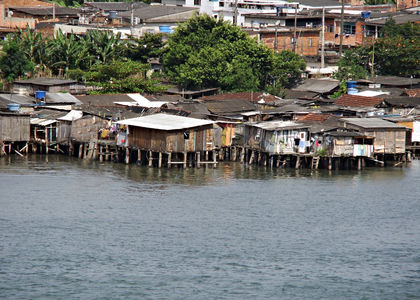Brazil - Poverty and wealth

Brazil has a few wealthy people and a large number of very poor people. The gap between the highest and the lowest social levels is high, even if it decreased during the late 1990s. Stabilization of the economy, through lower inflation levels, has given more purchasing power to the poor. Social indicators show that since 1994, when Fernando Henrique Cardoso became president, the percentage of people living below the poverty line decreased from 19 percent of the total population in 1993 to 14.51 percent in 1999, the lowest level in decades.
The income received by the top 10 percent of the Brazilian people represented 47.75 percent of the total income received in 1999. Meanwhile, the income received by the bottom 50 percent of the Brazilian people represented only 12.55 percent of the total income received in 1999. The top 1 percent of Brazilian people received 13.31 percent of the total income in 1999, more than the income for the bottom 50 percent combined.
Health services are free for all Brazilians, but the service is questionable. Medical doctors are well educated, but the demand in urban areas is much higher than what is available. Health and sanitary conditions vary from region to region. The south and southeast have better health services and sanitary conditions than the north and northeast.
| Distribution of Income or Consumption by Percentage | |
| Share: Brazil | |
| Lowest 10% | 0.9 |
| Lowest 20% | 2.5 |
| Second 20% | 5.5 |
| Third 20% | 10.0 |
| Fourth 20% | 18.3 |
| Highest 20% | 63.8 |
| Highest 10% | 47.6 |
| Survey year: 1996 | |
| Note: This information refers to income shares by percentiles of the population and is ranked by per capita income. | |
| SOURCE: 2000 World Development Indicators [CD-ROM]. | |
| Household Consumption in PPP Terms | |||||||
| Country | All food | Clothing and footwear | Fuel and power a | Health care b | Education b | Transport & Communications | Other |
| Brazil | 22 | 13 | 18 | 15 | 34 | 4 | -6 |
| United States | 13 | 9 | 9 | 4 | 6 | 8 | 51 |
| Argentina | 30 | 9 | 17 | 15 | 15 | 5 | 9 |
| Colombia | N/A | N/A | N/A | N/A | N/A | N/A | N/A |
| Data represent percentage of consumption in PPP terms. | |||||||
| a Excludes energy used for transport. | |||||||
| b Includes government and private expenditures. | |||||||
| SOURCE: World Bank. World Development Indicators 2000. | |||||||
Despite a government program against illiteracy, developed in 1971, 15 percent of the population aged 15 and higher were still illiterate in 1999. This number is higher than the percentage in Latin America and the Caribbean Islands as a whole. The percentage of illiteracy among the upper-middle class is 10 percent. Education is free at the school and university levels. Secondary school is the responsibility of the municipalities, and universities are the responsibility of the federal and state governments.
The biggest social challenge facing the Brazilian government and society is the lack of education, housing, health care, and nutrition for the homeless children of Brazil. Thousands of children live in the streets, abandoned by their parents who cannot afford to raise them. Confronting starvation and living in deplorable conditions, these children abuse drugs, commit crimes, and resort to prostitution in order to survive. The government has developed programs through the Ministry of Social Assistance to combat the poverty and starvation of homeless children.
THANKS VERY MUCH FOR THE ARTICLE IT WAS VERY INTRESTING
it helped alot and now i have a A+